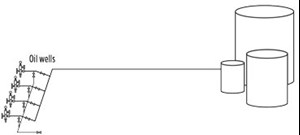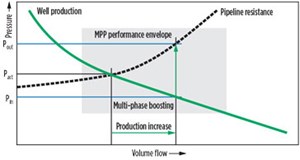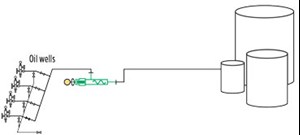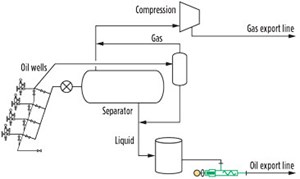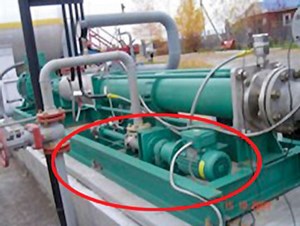Progressing cavity pumps optimized for multi-phase fluids
Increasing production of heavy oil, extra-heavy oil, and bitumen is critical to improving the economic viability of these oilfield developments. Thick crudes generally require special production techniques to overcome their high viscosity. While many in the industry have focused on methods such as steam-assisted gravity drainage (SAGD), cyclic steam injection (CSI) and vapor recovery, flow assurance solutions are also of vital importance.
These well streams are a combination of crude oil, water, gas and sand; the proportions of each vary by region and reservoir. There are distinct economic, environmental, and facilities management advantages to transferring the complete well stream to gathering and processing facilities, rather than separating the components at the wellsite. To make this transfer, the pump system selected must be reliable, safe, and capable of handling the variations in fluid composition and process conditions.
Positive displacement pumps, especially the progressing cavity pump (PCP), are a good choice for multi-phase fluid transfer for crude oils with high viscosity. The PCP is a cost-effective solution, compared to other conventional oilfield in-field pumping alternatives.
RESERVOIR STIMULATION
In recent years, many operators have tried to increase production rates by using new techniques to stimulate reservoirs. Most of these methods require flow assurances and surface transport techniques. Selecting pumps to transport multi-phase fluids, consisting of oil, water, gas, and formation solids (sand), is especially important. Multi-phase fluids in traditional field developments will typically flow freely to gathering stations, through surface lines pushed by natural formation pressure, Fig. 1. However, heavy oil and extra-heavy oil pose particular challenges for flow through pipelines, because the increased viscosities result in high friction losses.
Figure 2 shows a typical production model for multi-phase flow. The flow assurance aspect is critical for carefully managing production rates. Flowline resistance can have a strong influence on the production rates. For heavy oil regions, it becomes a key factor in deciding the specific production philosophy.
A simple way to use a multi-phase pump is shown in Fig. 3, where the pump is applied at the wellhead to simply boost the well flow to gathering and processing stations. In this case, multi-phase pumping is a way to add energy to the unprocessed well fluids, which enables the liquid/gas mixture to be transported over long distances without the need for prior separation.
There are typically two in-field separation operating scenario options: 1) conventional separation (Fig. 4), either close to, or at, the wellsite; and 2) use of a multi-phase pump. Separation close to the wellsite is not always possible, and may require significant infrastructure and investment. This increases facility investment costs, due to the complexity of the extreme environmental conditions; for example, cold temperatures, in which heavy oil fields are often located.
The information suggests that multi-phase pumping may be the simpler choice from an equipment perspective. From an environmental point of view, using an enclosed system to handle gas with little or no need for gas venting to the atmosphere is the more desirable option.
Pumps located at the wellhead or on pump pads must handle changing process conditions, due to the variations in formation and well behavior. This is especially an issue for the many multi-phase pumps deployed in depleting fields, which have a tendency to demonstrate unstable cycling behavior, characterized by an active production period followed by an inactive period. In addition, the unprocessed multi-phase oil streams may have entrained (free gas) fractions as high as the high nineties.
The pump equipment is already coping with challenging conditions, so when sporadic slugging is thrown into the equation, it can affect the pump. The slugging can result in gas flow only for periods lasting from 15 min. to several hours. The pump must be able to cope with such variations. During gas slugging periods, it is likely that some liquid will be carried with the gas as a liquid or vapor. The worst-case scenario for a pump is long duration of dry gas flows, which is tantamount to dry running of the pump. These technical design and control challenges must be overcome, to ensure equipment is reliable and efficient when placed into service.
INSTALLATION CHALLENGES
While there are several benefits to installing multi-phase pumps, there is also a variety of challenges posed by process and environmental conditions. The following conditions must be addressed in any successful multi-phase pump package:
- Well shut-in pressure is often high, >20 bar. Pump suction side design is for the shut-in pressure, as well as the normal running pressure, which is typically much lower.
- Varying inlet pressures lead to varied required displacement volumes, so the pump must have a variable speed drive that can vary the flowrate.
- The pump must be able to tolerate periods of gas slugging.
- Installation is nearly always outside, so the pump must be able to handle extreme heat and cold.
DESIGN AND INTEGRATION
Good system integration is required to overcome process challenges, including prolonged slugging. More than in any other PCP application, the system needs to be orientated to work with the pumps, to ensure that the equipment is not damaged during such times.
A method to protect against damage from overheating caused by prolonged slugging or dry running is available. The dry run protection device, embedded in the stator, can detect frictional heat buildup due to lack of lubrication from the pumped fluid. The control system can react by starting a lubrication pump. In the simplest form, the dry run protection can just trip the pump until the temperature subsides. System complexity will vary, based on geographical location.
Figure 5 shows a small lubrication pump injecting liquid into the suction side of the pump. Lubricant injected is collected process fluid or can be water or oil from separate sources. Another example is a simple liquid collection tube and recycling line arrangement, which has been used widely in Russian oil fields. It is usually applied with a recycle line flow controlled by a manually set throttle valve. The leakage collection device is sized to give a buffer of fluid to allow a reasonable operating period during typical slug flow durations.
ENVIRONMENTAL CONSIDERATIONS
Pump equipment must be protected from harsh environmental conditions, especially extremely cold temperatures. Because the pump stator is made of an elastomer, effective pump operations depend on the material remaining flexible. In colder temperatures, the elastomer tends to become less supple, and tear strength reduces. As they approach the glass transition point, pieces of the stator material can become mechanically overworked and shear off. However, elastomer recipes can be adjusted to increase the rebound rate and circumvent the effect of low temperatures. Alternative stator material recipes have been successfully and reliably applied in extremely cold Russian oil fields.
Mechanical seal selection is less critical than might be expected. It is essential that “O” ring material is selected, based on the expected temperatures, especially when operating in exceptionally cold environments. Seal selection depends on the gas fraction and the expected risk that the field could operate in slugging conditions.
For low gas fractions (<60%), using single mechanical seals, with either no quench (API plan 02) or a simple quench (plan 62), has proven successful. Where gas fractions are higher, the use of higher integrity solutions can be considered, such as double mechanical seal and systems. The simpler the solution, the more reliable it is likely to be. Even for higher gas fractions, the use of tandem seals with simple atmospheric buffer fluid tanks is effective, and avoids the need for more expensive and complex double seal and plan 53 systems.
It is also important to carefully select the buffer or barrier fluid. Use of 75/25 glycol/water solutions and diesel has been successful, with upgrades to fluids like isopropyl alcohol (isopropanol) or methanol.
PCPs are forgiving to mechanical seals, because the shaft speeds are very low, and stuffing box pressure is the same as the suction pressure. Only one shaft seal is required, unlike twin screw pumps with four shaft seals.
VALUE PROPOSITION
PCP equipment can be optimized easily to meet the demands of multi-phase oilfield requirements. Elastomer selection is essential to deal with cold conditions. Additionally, the use of package process and control solutions is especially critical. A PCP is simple to control; temperature increases are easily detected, and the pump responds quickly to control adjustments. The fluid handling qualities are extremely useful for moving low or very high viscosities. The PCP can also handle gas fractions as high as 99% and can tolerate slugging conditions without requiring control systems.
- Advancing offshore decarbonization through electrification of FPSOs (March 2024)
- U.S. oil and natural gas production hits record highs (February 2024)
- What's new in production (October 2023)
- FPSO technology: Accelerating FPSO performance evolution (September 2023)
- What's new in production (August 2023)
- A step-change in chemical injection (August 2023)

